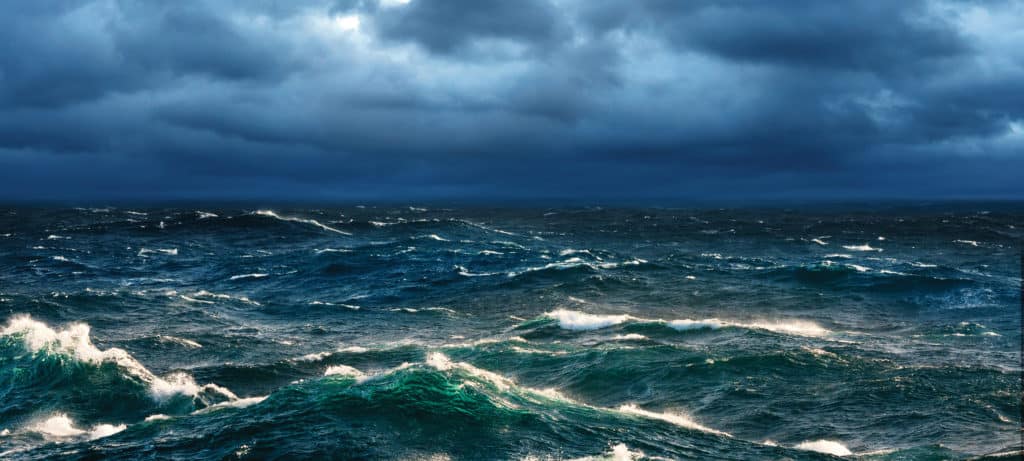
If you get a big enough chart, sailing from Maine to Bermuda looks easy. You’ll drop the mooring in Portland, motor east until you finish your coffee, get the sails up and point her south. Along the way, you’ll pass through at least three marine protected areas plus the Gulf Stream, and you imagine that these will inspire you with glorious sea mammals, birds and wonders of the deep.
That was my daydream, anyway, and the marine protected areas delivered, but wow, the sailing was hard on body, boat and spirit, with headwinds, steep seas and gusty nights. In short, we got our butts kicked going down there, but the splendors of wild nature compensated for the broken rigging. While there’s much to say about the mistakes I made as a sailor and the lessons I learned en route, there’s even more to say about encountering whales, dolphins and coral in ocean spaces favored with environmental protection.
I assembled an eager crew for this classic passage, though not one you’d confuse with professional racers or delivery skippers. We were neither polished nor salty. My work and my home are in Utah, but I go back to sea level and launch my old Beneteau First 42, Nellie, whenever I can. This Bermuda venture was her longest passage yet. Derek Holtved is a climbing friend from Banff, Canada, who once crewed on 12-Meters. He is the most competent sailor I know, with a dogged attention to detail and an aptitude for mechanical invention. Rieko is married to Derek. They met in Japan, and she’s much bigger than her 4-foot-10-inch frame. She has plenty of saltwater knowledge from the time she and Derek lived aboard their own boat. Last but rarely least is my father, Ted McCarthy — 75 years old for this voyage, with a lifetime of sailboat racing behind him and an abundant supply of anecdotes involving running aground, hitting other boats and dragging anchor, each of which makes Derek grumble, mutter and blush.
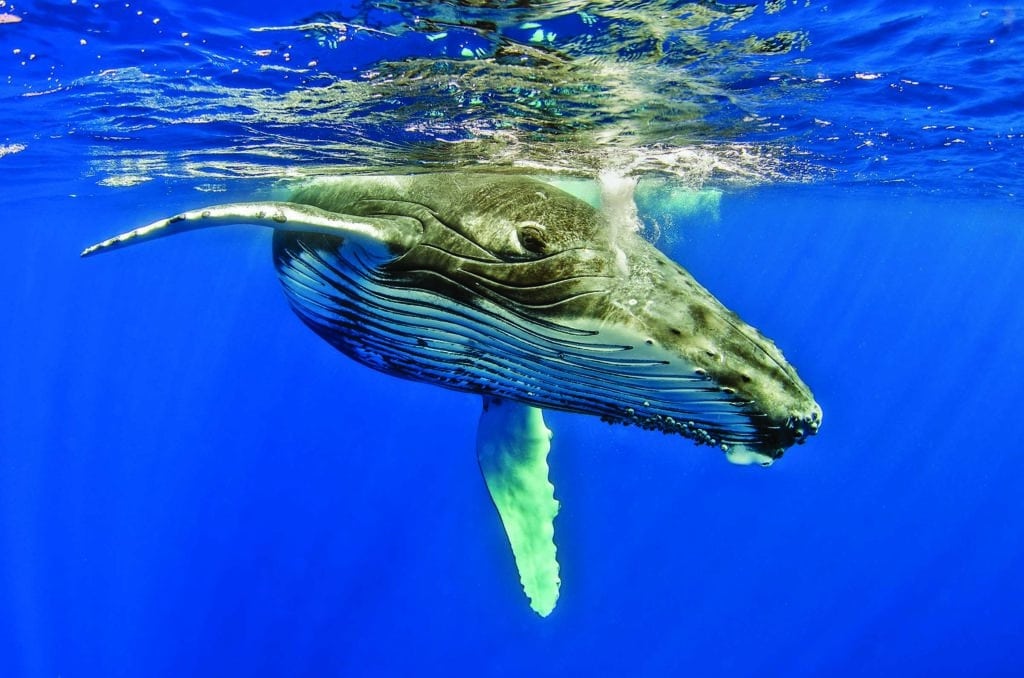
43.55° N and 70.10° W. Wind SW 11. Seas 2 to 3 feet.
We left Portland Harbor on the tide and set the big genoa to beat into a southwest breeze, and soon Derek and I were talking through our philosophies of sailing. He argued that sails are set to reach a waypoint; I held that sails are set to put us in the best relation to nature’s forces. Derek said, “So I use nature to go great places, and you go to the great places nature sends you.”
“Yes,” I said while adjusting the genoa car. “And we both feel better for it.”
If sailing invigorates us through close contact with the wilderness, then marine protected areas (MPAs) are the places sailors will feel most alive. At heart, MPAs are as straightforward as their name — they are marine environments legally dedicated to the preservation of natural and cultural resources. Basically, these areas promote biodiversity and systems resilience in the face of harsh forces like pollution, overfishing or ocean acidification.
But they’re not fenced zones excluding you; most MPAs allow some extraction, and nearly all invite visitors, balancing the interests of conservationists, fishermen and other economic stakeholders. Cruisers can see firsthand the ways MPAs refigure stressed marine environments into healthy parcels where depleted species can repopulate and ecosystems can rebound. There are tiny MPAs, such as Buck Island Reef National Monument’s 176 acres in the U.S. Virgin Islands, and huge ones, such as Papahanaumokuakea’s 500,000 square miles in the northwestern Hawaiian Islands.
42.15° N and 70.10° W. Wind SW 21. Seas 4 to 5 feet, with building chop.
You don’t have to go to the exotic edges of the planet to experience MPAs. We sailed right through the amazing Stellwagen Bank Marine Sanctuary, jibed past the new Northeast Canyons and Seamounts Marine National Monument, and spent days within Bermuda’s protected coral reefs.
In Stellwagen Bank, I saw a right whale on our first day of sailing, and we were still close enough to shore that I had a Red Sox game on the radio. Rieko was at the helm, and from the top of a swell, said, “See that?” She pointed to port, and two waves later, a splash was clear against the sunset. I assumed it was a humpback, but when it came up two more times to blow, I could see the head coloring and black fins did not match my expectations. Right whales are endangered and long-hunted creatures now making a slight rebound in protected areas. Derek and Rieko wondered at this ocean display so close to New England’s biggest city. A look at the chart showed Stellwagen Bank like a catcher’s mitt between Cape Cod and Cape Ann, all set to receive whatever Boston pitched seaward. First, we saw these bobbing, spouting right whales, and later, a group of rowdy humpbacks, slapping their fins and breaching in a cloud of seabirds. The sanctuary’s rules are clearly marked on all charts — mandatory ship reporting in critical right whale habitat — and they seem to be working.
39.49° N and 69.50° W. Wind SW 19. Seas confused.
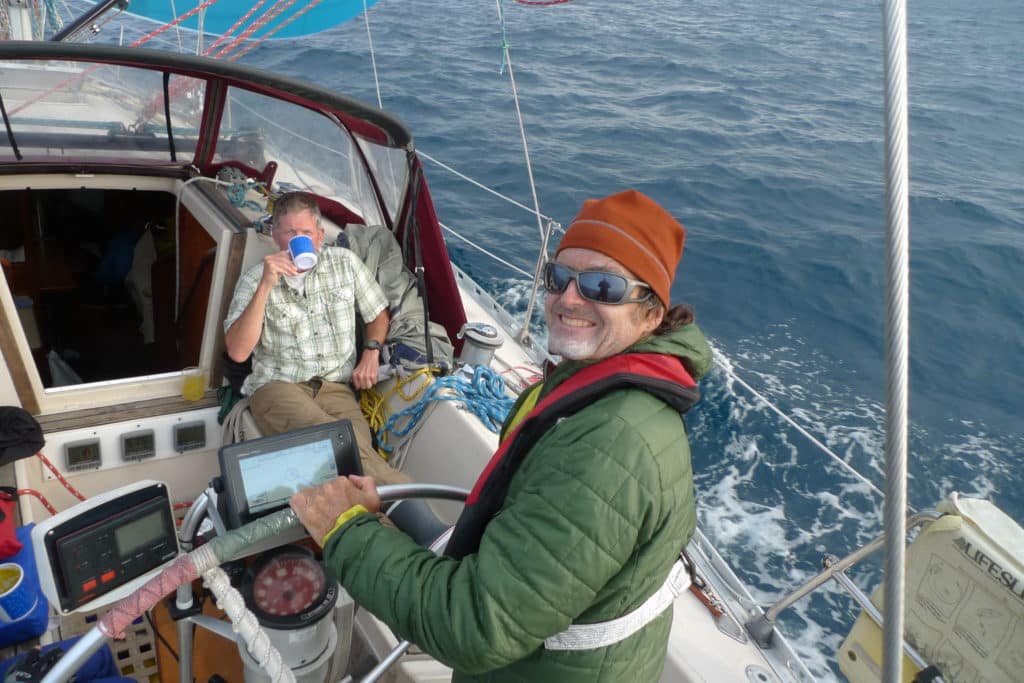
Three days out, with hundreds of miles to go, my dad and I chatted through the 0400-to-0800 watch. Despite the big wind, I found this watch easier than the midnight-to-0400 shift because the sun was coming up, and with the day came visibility, warmth and then breakfast. The sleek head and back of a dolphin bobbed and submerged, bobbed and submerged, and I hoped he would bring a friend to play on our bow wave. It was our proximity to the Gulf Stream that brought the wildlife this time — too rough for commercial fishing, too deep for drilling — protected by its own heat and momentum.
These encounters with living sea creatures mattered. Biologist E.O. Wilson coined the term biophilia for that unnamable connection humans feel toward animals — “the urge to affiliate with other forms of life,” as he put it. Out at sea, days from anything more solid than sargasso weed, I felt the warmest affection for this passing mammal, and I waved as you would acknowledge a stranger on a country road.
I love that sailing brings me closer to nature. There’s the rapt attention to sea state, clouds and breeze, and there are the hours in the cockpit where my eyes and ears conform to the rolling swell and open to the variation of a whale’s breath or a shearwater at work. In a sailboat, I become part of the sea’s broad rhythms and open myself to the nuances of a natural world that my terrestrial life tends to obscure behind Netflix and big-box stores. My dad quoted Wordsworth, who celebrated a heightened nature sensitivity: “So might I, standing on this pleasant lea, / have glimpses that would make me less forlorn; / have sight of Proteus rising from the sea; / or hear old Triton blow his wreathed horn.” Exactly right. These old sea gods recede when I am getting and spending, but they come back in a hurry as I reef a sail at night or pray for a fair current. Ahead, the Gulf Stream’s train of tall clouds puffed always west to east, west to east. Around us seabirds bobbed in the warm waves. Tacking along with two reefs and the small jib, we were focused on the natural systems that carried us along and rewarded us for our attention.
35.56° N and 68.17° W. Wind SE 14 and building. Seas 4 feet and confused.
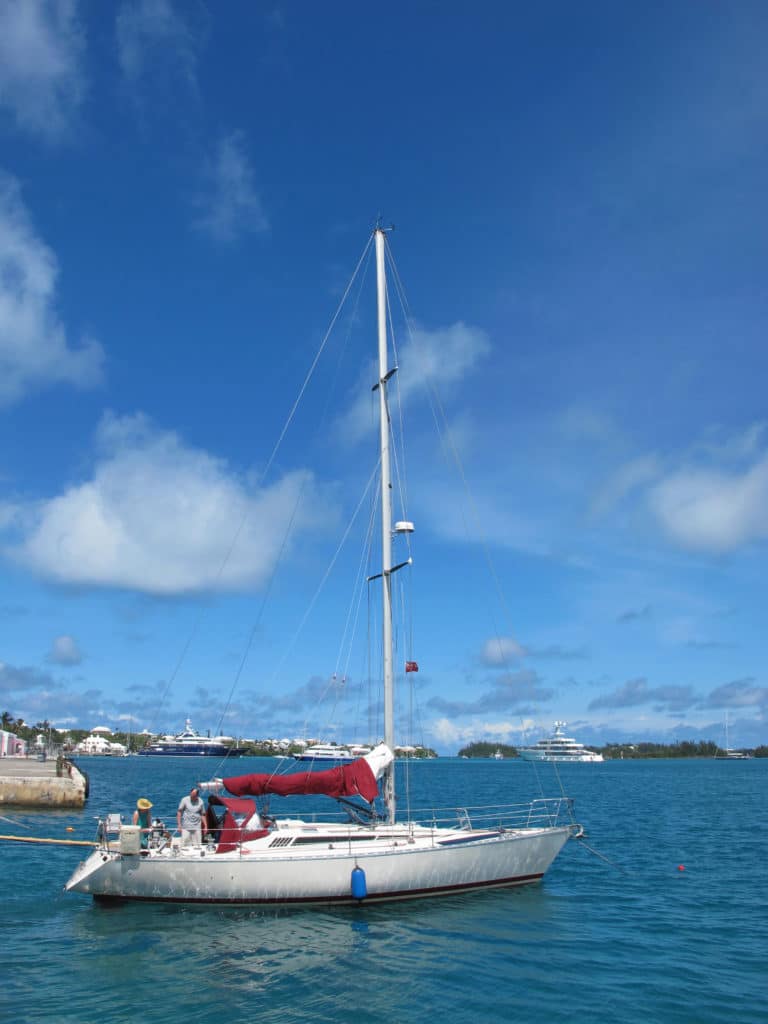
Out on the other side of the Gulf Stream, our attention to nature wasn’t what it could have been. Derek and Rieko were paying full care to the size of our sails — one reef in the main and a partially furled jib moved us at a steady 5 knots through mischievous seas — but sliding past us was yet another Mylar balloon. This one read “Party!” The ocean was speckled with this garbage. Was there once an innocent, pollution-free time? A time when a vibrantly red sunset meant good weather would follow and not excess particulates clogging our atmosphere? We were 300 miles from Bermuda, floating on 12,000 feet of open water, but we still saw flaps of plastic and foam cups. Byron wrote, “Man marks the earth with ruin — his control stops at the shore.” I hate to burst these Romantic bubbles, but it seemed to me that our vast and limitless oceans are actually the primary casualties of climate change. Most notably, the Atlantic that rolled under me is both warming and acidifying thanks to high levels of carbon in the atmosphere.
MPAs are one way to advance the cause of sustainable seas — by taking the pressure off one fertile zone, the whole system rebounds. Just as any sailor knows it’s time to adjust course when they are sailing by the lee, we need to recognize that signs of an ocean in crisis are all around us: one-third of the Great Barrier Reef bleached in 2016; acidifying waters suppressing mussel populations on the coast of Maine; heat expansion bringing us sea-level rise; warmer water killing coral from Tortola to Kiribati. According to the National Oceanic and Atmospheric Administration, the three hottest years on record were 2016, 2015 and 2014. If the ocean absorbs three-quarters of that global heat, it should be no surprise that there are bigger storms coming to further tax the ecosystems of every shore. Looking to windward, it’s clear that sailors are on the front lines of these changes. We can take an active role in witnessing ocean change and advocating ocean health.
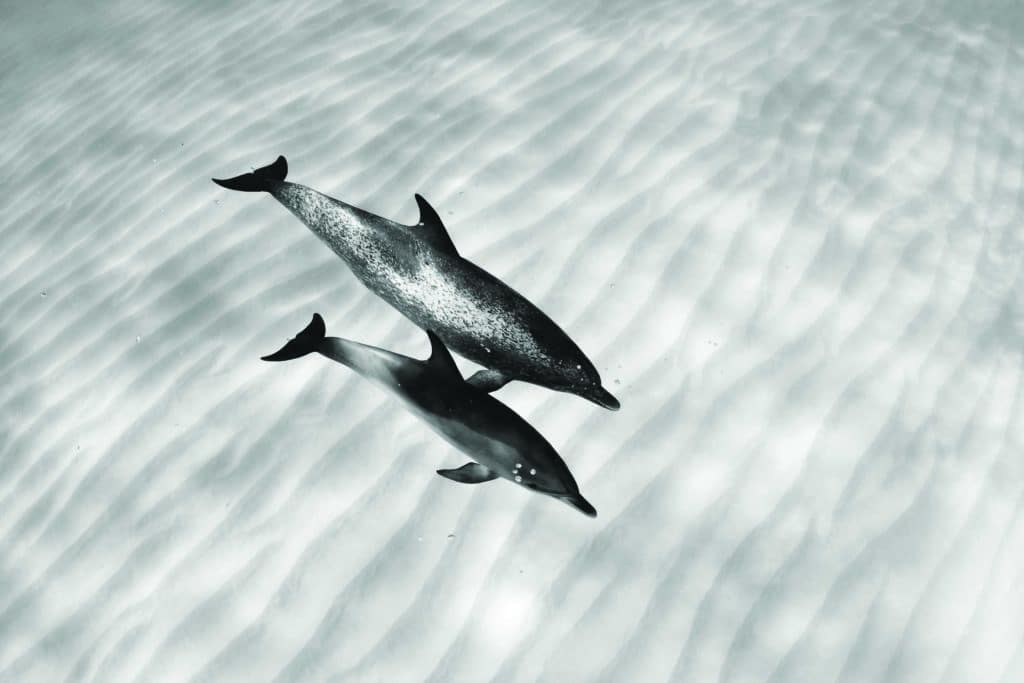
Mother and baby Atlantic spotted dolphins (Stenella frontalis) swim together in the sandy shallow waters of the Bahamas.
32.7° N and 64.4° W. Wind S 9. Seas 2 feet.
When a forestay breaks at sea, there’s a special kind of sound. Just over 20 nautical miles out from Bermuda, I was at the nav station admiring our progress when a thumping pop made the boat shudder, and I felt something bad, something structural. Derek knew what it was immediately — “Forestay!” — and things were happening fast. On deck, the genoa and furling gear were pressing into the shrouds, tumbling in slow motion. Wrestling the spinnaker halyard through that tangle to affix it forward while crying, “Slack, slack! Tension!” was the work of a long minute. Dropping the sail and lashing the rigging aboard took longer, and we had time to appreciate the daylight and the calm sea. We were unlucky to break the forestay, though lucky to do it by day; unhappy to need repairs, but glad to be so close to shore. Motoring through St. George’s Town Cut near midnight, we felt relief mingled with humility and plenty of gratitude toward providence.
When I woke up, I woke up on Bermuda. This unlikely seamount, preserved by the same coral reefs that threaten sailors, has its own story of marine protection. At the Bermuda Institute of Ocean Sciences (BIOS) Chris Flook told me that Bermuda has protected sea turtles from overfishing since 1620. 1620! BIOS Ocean Academy director Kaitlin Noyes explained Bermuda has the Atlantic’s northernmost coral reefs, and they are critical libraries of marine ecology while southern reefs bleach and suffer.
I swam with Chris and Kaitlin beside North Rock, marked on my chart as a shallow to avoid like grim death in a sailboat, but when seen from underwater, it’s a gloriously thriving ecology of brain corals and star corals circled by parrotfish, grouper and myriad creatures. This ecosystem is one of several dozen MPAs in Bermuda, and it was heartening to feel that same ocean that rocked me from Maine course through the healthy fans and branches of living coral.
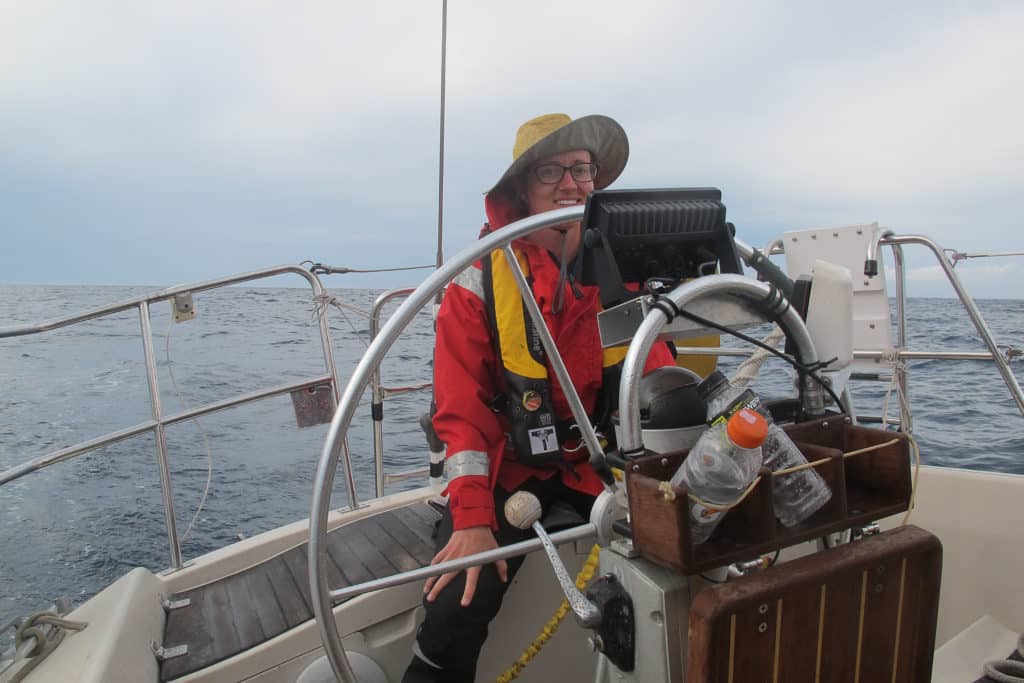
38.1° N and 67.4° W. Wind SW 12. Seas 3 to 4 feet.
After nine days of sweaty boat fiddling, I left Bermuda with a new crew and a new forestay. It was a relief to be moving, a necessary change to the tedious round of asking after parts not delivered and speaking politely to tardy mechanics. We motored out with the sunset behind us, and once we could leave North Rock well to port, turned north under full sails. Whitney, my wife, is a good sailor. She loves nothing better than snorkeling among tropical fish, and she had pointed to Bermuda’s oversize footprint on the big chart and said, “Imagine all those miles of reef, all those fish. What a paradise.” Now she was eager to see dolphins, whales and sharks. On that same plotting chart, I penciled quick circles around the marine sanctuaries, preserves and monuments in our path to Newport, Rhode Island. These were the places she was most likely to encounter the sea life that inspired her sailing. One of the newest MPAs is the Northeast Canyons and Seamounts Marine National Monument, 120 miles southeast of Cape Cod. We hadn’t planned to go near it on this leg, but on day three, the Gulf Stream hit us with 25 knots of breeze from the southwest and then a series of westerly squalls that soaked our plans in flying spray. Ten hard hours saw us 60 miles east of our line and barely a daysail from the new monument. Unlike, say, Devil’s Tower or Gettysburg, sea canyons are not something you can spot from a distance or tour in a bus. But a healthy ocean has its language too, and in the morning, Whitney spotted a spout to starboard, and then another. Before long, she had the rhythm and guided us to the long forms of North Atlantic fin whales feeding in the middle distance.
The Northeast Canyons and Seamounts Marine National Monument was designated in 2016 to manage the waters above three canyons 4,000 meters deep and four undersea mountains with 2,000 meters of relief from the ocean floor. The monument aims to shape spawning grounds and habitat into a pocket of resilience amid an ocean of pollution and fishing gear.
41.47° N and 71.32° W. Ida Lewis Yacht Club, Newport.
MPAs are a bright spot in the gloomy conversation about ocean health. We reached Newport in 115 hours from St. George’s, in time for July Fourth festivities on the harbor: hundreds of boats and people, fireworks and music. These happy mariners seemed ready to agree with Arthur C. Clarke’s observation, “How inappropriate to call this planet Earth when it is quite clearly Ocean.” There was a sea story in each of these skiffs, dories, tugs, racers and ferries. Nellie’s Bermuda trip was one tiny sailing tale, but in its brushes with ocean conservation it carried an optimistic message to offset climate-change fatalism.
The voyage to Bermuda and back showed me a lot of ocean, and successful efforts for protecting it. In my log’s notes, a white-sided dolphin leapt clear of the Gulf Stream, coral fans fluttered in the Bermuda current, humpbacks fed in Stellwagen Bank — all these gave me hope for a cruising future that includes turtles, corals and the great whales that brighten even our foggiest days.
– – –
Jeffrey McCarthy is director of the environmental humanities graduate program at the University of Utah.








